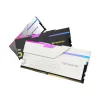(Acer) Predator Hermes 6800 MHz CL32 2 x 16 GB
Predator (and overall Acer’s) storage products are manufactured under official license by BIWIN Technology (for example, it’s also applicable for HP SSDs/RAM). The presented Hermes series has various available frequencies and kits of multiple capacities. The sample we got is 6800 MHz, 32 GB (16 GB x 2), and CL32-45-45-108, but there are also ones starting from 6400 MHz and reaching up to 8000 MHz. As for the capacities, you can get:
- 32 GB: 16 GB x 2
- 48 GB: 24GB x 2
- 64 GB: 32 GB x 2
Regarding the offered models, there are the following:
- 6400 MHz, 32 GB (16 GB x 2): CL32-39-39-102 @ 1.4 V
- 6400 MHz, 64 GB (32 GB x 2): CL32-39-39-102 @ 1.4 V
- 6600 MHz, 32 GB (16 GB x 2): CL34-40-40-105 @ 1.4 V
- 6800 MHz, 32 GB (16 GB x 2): CL32-45-45-108 @ 1.4 V
- 6800 MHz, 48 GB (24 GB x 2): CL34-46-46-108 @ 1.4 V
- 7200 MHz, 32 GB (16 GB x 2): CL34-45-45-115 @ 1.4 V
- 7200 MHz, 48 GB (24 GB x 2): CL36-46-46-115 @ 1.4 V
- 7600 MHz, 32 GB (16 GB x 2): CL36-46-46-121 @ 1.4 V
- 8000 MHz, 32 GB (16 GB x 2): CL36-48-48-126 @ 1.45 V
There are three color variants:
- Black
- Silver (which we got)
- White
It’s a series with an XMP profile. Our sample is not the highest frequency kit from the Hermes series, with a 6800 MHz clock, CL32-45-45-108, at 1.4 V. Overall, the Acer Predator Hermes DDR5 memory kit is an interesting option for those looking for high-performance memory with low latency and RGB lighting. You also get (for the 6800+ MHz variants) - a 40 x 40 x 10 mm fan, 4.72 CFM airflow, and a maximum noise of 29.9 dB. The Hermes DDR5 has the PMIC for enhanced overclocking performance and a 10-layer PCB for the same purpose. Also, there’s a built-in thermal sensor, so this ram offers real-time temperature monitoring.
A quick reminder - DDR5 is the newest technology to hit the market, make headlines, and break world records. DDR5 already set spectacular results in overclocking (of course, using the LN2), even at 11648 MHz (single channel, using the Intel platform). DDR4 RAMs operate on a single 64-bit bus, while DDR5 has two 32-bit buses (plus, in both cases, an additional 8-bit for ECC). As a result, a single module is identified as a Dual Channel, while two are identified as Quad Channel. However, the solution does not match the throughput of HEDT platforms with processors with a four-channel controller. The internal (A / B) channels of DDR5 RAM also share the RCD (Register Clock Driver), which provides more output signals and more extended pulse reading (8 vs. 16). The DDR5 comes with a Power Management Integrated Circuit (PMIC) from the most important things you need to know. It’s responsible for controlling voltage changes, optimizing the energy draw, and making it less demanding for the motherboard controller. The DDR4 nominal voltage is 1.2 V; for the DDR5, it’s 1.1 V. Typical XMP voltage for the older type of memory is 1.35V (sometimes 1.45 V); now, it’s mostly 1.25 V. Speaking of the XMP, till now, it was 2.0 revision, with the introduction of the DDR5 we’ve got the rev 3.0. The main difference is that the number of profiles has increased from three to five (three for the manufacturer settings and two placeholders for the users).
The RGB can be controlled via the following:
- Asus Aura Sync
- Asrock Polychrome RGB
- Gigabyte RGB Fusion 2.0
- MSI Mystic Light Sync
There are eight independent lighting areas, 16.8 million color values, and 10+ diverse lighting effects.
The memory module is 51 mm/2.00 inches high, so it’s relatively high-profile, which can cause problems with the (air) CPU coolers.
We’ll check the kit on two platforms, with Z790-based motherboards (Asus Z790 Maximus Hero) combined with the Intel Core i9 13900K and the Asrock X670E Steel Legend combined with an AMD Ryzen 9 7900X. The used GPU is the Nvidia Geforce RTX 4090, so it shouldn’t be a limiting factor for memory performance. We are traditionally going to try and squeeze something more out of it. You can always stay safe and stick to the advertised frequency and latencies using XMP 3.0. The default parameters and visual aspects look attractive, so we must check the performance then. A limited lifetime warranty backs the Acer Predator Hermes series. For this kit, you’ll need to pay around 180 USD. Ok, next page, please.


